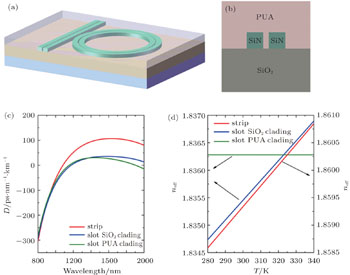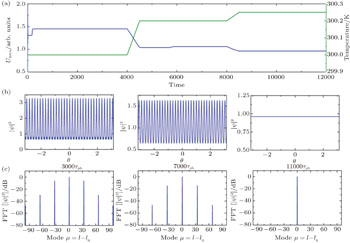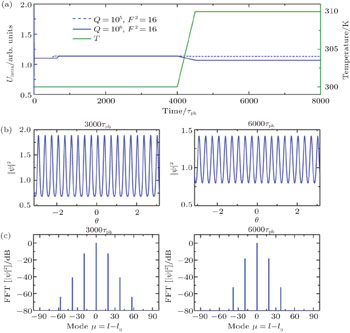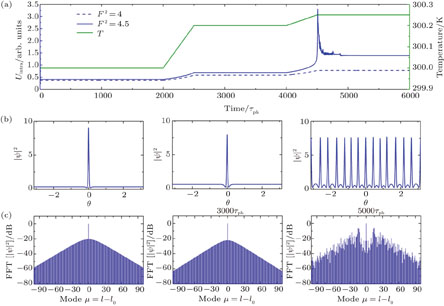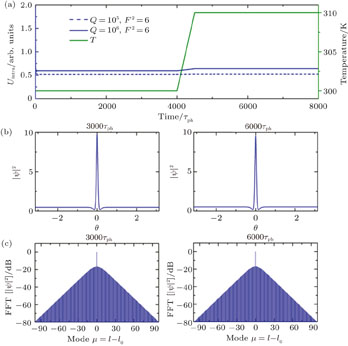† Corresponding author. E-mail:
Project supported by the National Natural Science Foundation of China (Grant Nos. 61435002, 61527823, and 61321063).
We numerically simulate the generation of an optical frequency comb (OFC) in a microring based on the traditional Si3N4 strip waveguide and a temperature compensated slot waveguide. The results show that OFCs are susceptible to temperature with strip waveguide while they can keep stable when temperature changes 10 K in either low-Q (105) or high-Q (106) microcavity with the well-designed slot waveguide, which has great superiority in practical applications where the temperature drift of the cavity due to the intense pump or surrounding change is unavoidable.
Optical frequency combs (OFCs)[1,2] have become a powerful tool for high precision spectroscopy and are thereby used for various applications such as sensitive gas sensing,[3] molecular fingerprinting,[4] optical clocks,[5] and attosecond physics.[6] A monolithic frequency comb generator has been demonstrated for the first time in Ref. [7]. This approach is based on continuously pumped fused silica micro resonators on a chip, in which frequency combs are generated via parametric frequency conversion through four-wave mixing.[8] An important aspect of OFC in metrology is the stabilization of the comb repetition rate (fr) and carrier envelope offset frequency (fCEO).[8]
Due to the high pump power coupled into the resonator, the optical modes experience a significant thermal frequency shift as a result of the light absorption in the micro resonator. Usually the pump light is tuned into a resonance from high to low frequencies and the heating of the cavity is balanced by convective and conductive cooling, which allows for “thermal locking” [9–15] of the micro resonator mode to the pump laser and has been successfully used for self-stability of microcavities. Self-stability can compensate for various types of noise, but it cannot compensate a continuous slow drift, such as the case that the room temperature changes a few degrees.[10] What is more, it will be an unstable thermal equilibrium when the pump wavelength locates at the long wavelength side of the resonance wavelength, which is necessary in the generation of OFC on certain conditions. So we need some new approaches to stabilize the OFC. By using electronic feedback on both laser frequency and laser power, a micro resonator Kerr comb has been fully frequency stabilized with a relative accuracy of 10−16.[12] However, this frequency stabilizing method is very complicated and expensive, which hinders some applications of the on-chip OFC such as multi-wavelength WDM light sources where the frequency stabilization is necessary but not as severe as those needed for high precise spectrum metrology. Therefore, a passive temperature compensation method is of great practical importance and highly desirable. In this work we numerically simulate the stability of OFC generated in a microring resonator based on a temperature-compensated silicon nitride slot waveguide.
We have recently designed a polyurethane acrylate (PUA)-cladding silicon nitride slotted waveguide,[16] which is shown in Fig.
To numerically demonstrate the influence of the temperature change on OFC generation in different waveguides, we simulate the comb generation process using the Lugiato–Lefever equation[20,21]

Turing rolls and (bright) cavity solitons[21] are two important forms of OFC, which both are taken into account in our simulation. The initial cold cavity temperature is set to 300 K, and the dispersion of the strip waveguide and the slotted waveguide is 105.6 ps/(nm·km) and 28.7 ps/(nm·km), respectively. The quality factor is assumed to be 100000, which corresponds to a waveguide loss of ∼2 dB/cm.[22]
We set the initial detuning as −0.02 nm and OFC is stimulated from a cold cavity of 300 K. We then simulate the evolution of the OFC while the temperature changes slowly, as shown in Fig.
The fluctuation of temperature may cause the change of frequency detuning, and then results in the movement of OFC in the parameter space. The change of OFC mainly depends on its initial position in the parameter space and the variation of frequency detuning. So OFC is more susceptible to temperature in high Q microcavity due to its narrow mode bandwidth. To show the stability of OFC generated in the temperature compensated slot waveguide, we also simulate the evolution of OFC in high Q microcavity. Comparing to the simulation in Fig.
The blue dotted curve in Fig.
Comparing Figs.
To show the influence of temperature on the evolution of soliton, we set the initial detuning as 0.03 nm and the process of simulation is similar to the above. First, we simulate the case for the traditional Si3N4 microcavity. The peak power of the soliton decreases while its duration increases as the temperature slowly drifts from 300 K to 300.25 K when the pump power is F2 = 4. But the evolution of soliton is quite different when F2 = 4.5. After a drastic oscillation, the single soliton splits into multi-solitons in time-domain and the envelope of the comb lines becomes irregular in the frequency domain when the temperature rises from 300.2 K to 300.25 K, as shown in Fig.
Then, we deal with the case for the temperature compensated slot waveguide under the same initial detuning condition. The result of Fig.
The small dispersion of slot waveguide is not beneficial to getting natively mode-spaced (NMS) combs,[24] but its flattened anomalous dispersion profile allows for the generation of a broadband frequency comb. The most important is that OFC is nearly not influenced by the fluctuation of temperature in this waveguide. These characteristics may make the microcavity based on the slot waveguide an ideal device for the generation of OFC.
We simulate the dynamic evolution of the Turing rolls and cavity soliton while the temperature changes slowly, which mimic the actual process. The results demonstrate that the microcavity based on the temperature compensated slot waveguide is much more temperature insensitive than the traditional strip waveguide. OFC stimulated from a microcavity based on the temperature compensated slot waveguide can keep stable when temperature raises 10 K. So the slot waveguide is of great practical importance in the application of OFC or other microcavity based optical devices.
| 1 | |
| 2 | |
| 3 | |
| 4 | |
| 5 | |
| 6 | |
| 7 | |
| 8 | |
| 9 | |
| 10 | |
| 11 | |
| 12 | |
| 13 | |
| 14 | |
| 15 | |
| 16 | |
| 17 | |
| 18 | |
| 19 | |
| 20 | |
| 21 | |
| 22 | |
| 23 | |
| 24 |



